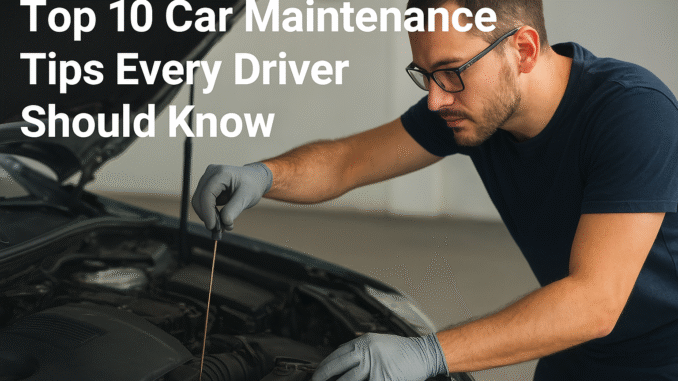
Top 10 Car Maintenance Tips Every Driver Should Know
Owning a car is more than just filling up the tank and hitting the road. To keep your vehicle running smoothly, safely, and efficiently, regular maintenance is essential. Whether you drive daily for work or only take weekend trips, knowing the basics of car care can save you money, extend your car’s lifespan, and prevent unexpected breakdowns.
In this article, we’ll cover the top 10 car maintenance tips every driver should know, with practical advice that’s easy to follow, even if you’re not a mechanic.
1. Regularly Check and Change Engine Oil
Oil is the lifeblood of your car’s engine. It lubricates moving parts, reduces friction, and prevents overheating. Driving with dirty or low oil can damage the engine and lead to costly repairs.
- How often to check: Inspect your oil level once a month using the dipstick.
- When to change oil: Typically every 5,000–7,000 miles (or as recommended in your car’s manual).
- Pro tip: Always use the correct oil grade specified for your vehicle.
Keeping your engine oil clean and topped up ensures smoother performance and longer engine life.
2. Inspect Tires and Maintain Proper Pressure
Your tires are the only part of your vehicle that touches the road, so they play a crucial role in safety, handling, and fuel efficiency.
- Check tire pressure: At least once a month. Low pressure causes poor fuel economy and uneven wear, while overinflated tires reduce grip.
- Rotate tires: Every 5,000–7,000 miles to promote even wear.
- Inspect tread depth: Use the “penny test.” Insert a penny into the tread; if you can see all of Lincoln’s head, it’s time for new tires.
Well-maintained tires not only improve safety but also help you save money on fuel.
3. Keep Your Battery in Good Condition
A dead battery is one of the most common reasons cars fail to start. Batteries typically last 3–5 years, but proper care can extend their life.
- Signs of trouble: Dim headlights, slow engine crank, or dashboard warning lights.
- Maintenance tips: Clean corrosion from the terminals, ensure a tight connection, and avoid leaving electronics on when the engine is off.
- Pro tip: Get your battery tested annually, especially before winter or long trips.
Regular battery checks prevent frustrating surprises on the road.
4. Replace Air Filters as Needed
Air filters prevent dirt, dust, and debris from entering your engine and cabin. Over time, clogged filters can hurt fuel efficiency and air quality.
- Engine air filter: Replace every 15,000–30,000 miles.
- Cabin air filter: Replace annually or when airflow weakens.
A fresh air filter helps your engine breathe better, improves fuel economy, and ensures clean air inside the car.
5. Monitor and Replace Brake Pads
Your brakes are your car’s most important safety feature. Worn-out brake pads can compromise stopping power and damage brake rotors.
- Signs you need new pads: Squeaking, grinding noises, or reduced braking performance.
- Check brake fluid: Low or dirty fluid can affect brake response.
- Pro tip: Have brakes inspected every 10,000–15,000 miles or if you notice unusual sounds.
Taking care of your brakes ensures safe driving in all conditions.
6. Keep an Eye on Fluid Levels
Besides oil, your vehicle relies on several other fluids for proper function:
- Coolant/antifreeze: Prevents overheating.
- Brake fluid: Essential for safe braking.
- Transmission fluid: Ensures smooth gear shifting.
- Power steering fluid: Helps with easy steering.
- Windshield washer fluid: Provides clear visibility.
Check fluid levels monthly and top them up when needed. Following your car’s service schedule ensures all fluids are clean and effective.
7. Replace Wiper Blades and Maintain Visibility
Clear visibility is crucial for safe driving, especially during rainstorms or snowy conditions. Worn wiper blades can smear water and reduce visibility.
- When to replace: Every 6–12 months, or if they leave streaks.
- Pro tip: Keep your windshield clean to reduce blade wear.
Good wipers combined with sufficient washer fluid make driving safer in bad weather.
8. Stick to the Manufacturer’s Service Schedule
Every car comes with a recommended service schedule, usually outlined in the owner’s manual. Following it is one of the smartest ways to keep your vehicle in top shape.
- Why it matters: Service schedules include vital checks like timing belt replacement, spark plugs, and fluid changes.
- Pro tip: Don’t skip scheduled maintenance—even if your car seems fine. Preventive care is cheaper than major repairs.
Consistent servicing ensures your car runs reliably for years.
9. Wash and Wax Your Car Regularly
Car maintenance isn’t just about the engine—it’s also about protecting the exterior. Dirt, road salt, and grime can damage paint and cause rust.
- Wash frequency: Every two weeks, or more if driving in harsh conditions.
- Waxing: Apply wax every 3–4 months to protect the paint and keep the car shining.
- Pro tip: Don’t forget to clean the undercarriage to prevent rust buildup.
A clean car not only looks good but also lasts longer.
10. Pay Attention to Warning Lights
Modern cars are equipped with dashboard warning lights for a reason. Ignoring them can lead to expensive problems.
- Common lights: Check Engine, Battery, Oil Pressure, ABS, and Tire Pressure Monitoring System (TPMS).
- Pro tip: If the light is red, stop driving immediately and seek help. Yellow or orange lights indicate non-urgent issues, but they still need attention.
Addressing warning lights early can prevent small issues from turning into major repairs.
Final Thoughts
Car maintenance may seem overwhelming, but following these 10 essential tips makes it much easier. By regularly checking oil, tires, brakes, fluids, and other key components, you’ll enjoy:
- Improved safety
- Better fuel efficiency
- Fewer costly repairs
- A longer vehicle lifespan
Think of car maintenance as an investment in your vehicle and your safety. A little effort now can save you time, money, and headaches down the road.
So, the next time you get behind the wheel, remember: proper car care isn’t just about keeping your vehicle running—it’s about making every drive safer and more enjoyable.
